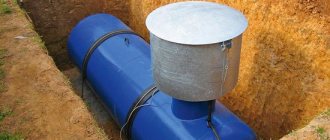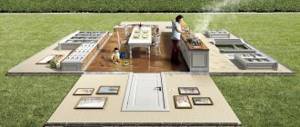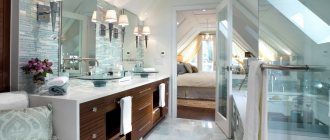Solar battery for home, garden
What to do if for some reason there is no electricity at the dacha?
You can, of course, adapt to such a life, enjoying time-tested technologies: use candles and a kerosene lamp for lighting, dig a cellar for storing food, carry water in buckets and heat it on a fire, give up the TV, etc. However, such a “rest” is unlikely to be truly comfortable: sooner or later you will still have to look for ways to generate electricity using alternative energy sources. Most often you think about this in the following cases:
- there is no way to connect a country house or country house to the power grid;
- connecting to the power grid is unreasonably expensive;
- accidents constantly occur at the substation, due to which there is no light for a long time;
- the site has been allocated too little power and is constantly in short supply (this usually happens in gardening partnerships with old electrical networks);
- I want to save on excessively high electricity bills.
The simplest and most affordable alternative energy source is solar panels. Silicon-based solar cells, connected in an electrical circuit to convert energy from sunlight into electricity, were invented in the United States and began being used on American and Soviet space satellites as early as 1958. Nowadays, they power portable equipment (calculators, thermometers, flashlights), spacecraft, electric cars and yachts, and even an airplane is being developed that will fly using energy obtained from solar panels.
Many countries have created large solar power plants, and the French government plans to lay 1,000 km of roads with built-in solar panels, so that each kilometer of such pavement will provide electricity to 5,000 people (excluding heating). Solar batteries have even found application in medicine: in South Korea, tiny solar cells are implanted into the patient’s skin to ensure the smooth operation of implanted devices, such as a pacemaker. Such long experience and widespread use of solar panels testifies to the reliability, cost-effectiveness and high efficiency of this technology.
In this article I will talk about my own experience of using solar panels in the country. First of all, it should be noted that in order to meet the electricity needs of a small country house, it is necessary to assemble an entire mini-power station, which, in addition to the solar panels themselves, includes batteries for storing charge, a controller for controlling the system and an inverter for converting direct current into alternating current.
On the subject: Can a dacha become a home?
Types of solar power plants
There are several types of solar power plants. Most of them are designed to produce energy on an industrial scale. The most common types are:
- Tower . Its operation is based on the principle of evaporation of water when heated by solar energy. There are reflectors around the tower, concentrating the light at its top, where a dark-colored liquid tank is located. They are mounted on supports with automatic adjustment of orientation relative to the sun. Solar power plants of this type operate as follows: the steam obtained from heating is sent to a turbogenerator located at the base of the central structure, and energy is generated there.
- Disc-shaped . The operating principle of such stations is similar to tower ones, but their design is very different. Here, each module has its own receiver and reflector aimed at it. The latter consists of an assembly of mirrors. The basis of the system is a Sterling engine connected to a turbine. The peculiarity of dish stations is that here each module independently produces electricity.
- Parabolic cylindrical . They also heat the coolant due to the light of the sun. Only the reflectors here have the shape of a parabolic cylinder up to 50 meters long. In front of them, a pipe with liquid is attached to rods. The heated coolant turns water through a heat exchanger into steam, which rotates the generator turbine.
- Photovoltaic . Without exaggeration, these are the most popular stations. They are used both in industry and in private homes. They are based on silicon elements that have sufficient performance to supply electricity to small objects. Such batteries are often installed on the roofs of houses.
At the end of the 30s of the last century, the idea of a solar-vacuum power plant was patented in France. It was implemented only in 1982 in Spain. The system is based on air movement resulting from temperature differences. It was not widely used due to its low productivity.
You may be interested in Which is the best voltage stabilizer for the home, reviews
Solar panels for a summer residence
The Russian market offers solar batteries (solar panels) of domestic, European and Chinese production. Our dacha has domestic solar panels installed - we bought them directly from the manufacturer in Zelenograd. There are several specialized companies in Moscow that offer both individual elements for self-installation of a solar mini-power plant, and a complete set of necessary equipment with turnkey delivery and installation. Specialists from these companies provide professional advice and consultations, and calculate the required power and system composition for each client.
Solar batteries have an unlimited service life. They produce 12V DC current. Depending on the size, the panels come in different capacities. To assemble an autonomous solar mini-power station, you need to purchase several solar panels. The exact number of batteries (more precisely, their required power) is calculated based on the potential energy consumption you need. On sunny summer days, the panels operate at maximum efficiency. In cloudy weather, the panels also generate electricity, but in smaller quantities. This must be taken into account when calculating the power of the system if you plan to use it not only in summer, but also in winter.
Price Costs of Photovoltaic Panels
Material prices are approximate because the cost of panels, inverter or mounting structure is greatly influenced by the type of devices selected, brand and manufacturer. Since most devices are imported from abroad, the current dollar exchange rate is also important.
Example of a list of materials for a 5 kW photovoltaic installation:
- Photocell system consisting of 20 250 W modules - 200,000 rubles;
- Fastening of aluminum profiles on a sloping roof covered with tiles - 50,000 rubles;
- An inverter that allows you to control the installation - 50,000 rubles;
- Connectors and fuses - 10,000 rubles.
- Installation of solar panels takes up to 5 days, for which we will pay the craftsmen 100,000 rubles;
Attention! This specification does not include the cost of batteries as they are an optional option in a solar power plant. An independent installation for a home, due to the need to store electricity, a different type of inverter and slightly more panels, will be 40% more expensive.
In autumn and winter, on cloudy days, the efficiency of a photovoltaic system decreases by approximately 50%.
Useful: Circuit diagram of a charger for a car battery (homemade)
Deep cycle batteries
The electrical energy generated by solar panels is stored in batteries. For efficient operation of the system, it is best to use special deep-cycle gel batteries, which do not require special maintenance, are sealed and safe when installed inside the house. For a small country house with minimal electricity consumption, at least 3-4 batteries with a capacity of 100-120 Ah each are required. They are reliable, durable and can withstand many charge and deep discharge cycles.
Battery charge controller
A controller is installed between the solar panels that generate electricity and the batteries that store this energy. Controllers vary in technical characteristics and cost. Oddly enough, this is the most important control element of a solar mini-power plant: the controller protects the batteries from complete discharge and from overcharging, which are very dangerous for them. In the event of an unacceptably low battery discharge, the controller turns off the load. In the case when the batteries are fully charged, the controller does not allow energy from the solar panels to flow into the batteries.
Insolation
Sunlight obviously plays a key role when it comes to solar energy, and not all regions have a level playing field in this regard. It's important to know how much sunlight reaches the ground in the area where your potential solar home is located.
What we're talking about here is called insolation - a measure of how much solar radiation will fall on the earth in a given area in a given period of time. This is usually measured in kW/m2/days and will tell you how much sunlight will be available for your solar panels to turn into electricity. The higher the insolation value in your area, the more electricity each of your panels will be able to generate. A high insolation value means you can get more energy from smaller panels. A low insolation value means you could end up spending more to achieve the same power output.
So you should build your solar home in the southwest instead of the northwest? Not at all. It just means you'll probably need more panels to achieve the same power output.
Inverter
Solar panels produce 12V DC, while most electrical appliances operate on 220V AC. Therefore, an inverter is included in the solar mini-power plant system, which converts 12V direct current into 220V alternating current. It is best to use more expensive inverters that produce a so-called pure sine wave current (“pure sine”). Cheaper inverters that produce modified sine wave current may not be suitable for some equipment.
On topic: Decorating a fence at the dacha: 30 ideas
Electricity consumers
As a rule, in all solar mini-power plants, separate sockets are installed for devices (consumers) operating on direct (12V) and alternating current (220V). Energy-saving lighting fixtures, water pumps, refrigerators and even televisions can operate from direct current. All other equipment requires 220V AC. If possible, choose equipment that consumes as little electricity as possible - there is a huge selection of such energy-saving devices on the modern household appliances market.











